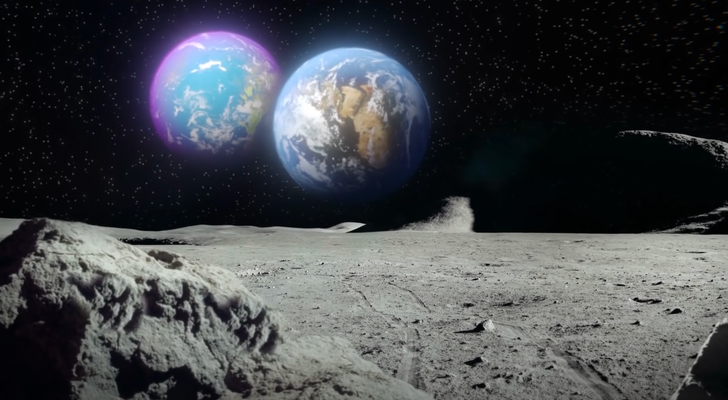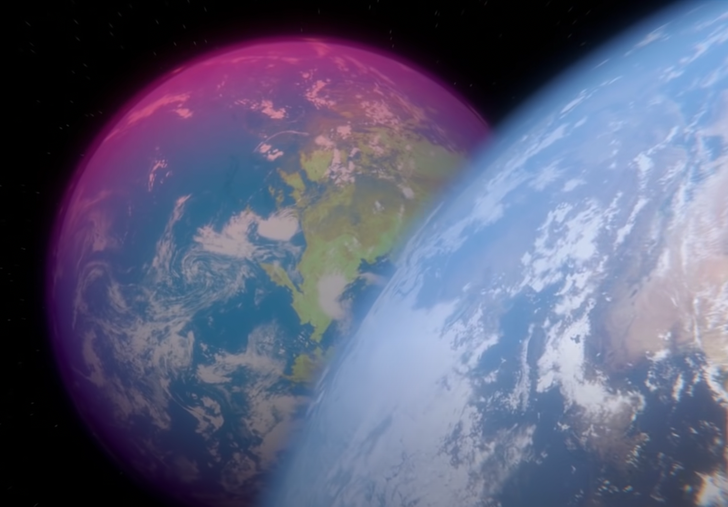Two Earths coexisting in our solar system would open up fascinating and challenging perspectives on life and planetary relationships. Could humans learn, cooperate, or face conflict from another civilization in the universe right next door?
Imagine that one day we woke up and discovered that there was not just one Earth in our solar system, but two. Two planets identical in size, climate, and life. It was a fascinating prospect, but it also raised countless questions: How could this happen? Could the two planets coexist peacefully, or would they face conflict? And would the people on “Earth 2” be like us?

The appearance of a new planet would significantly change the gravitational pull in the Solar System. This could cause disturbances in the orbits of existing planets, even leading to collisions between planets.
Discover "Earth 2.0"
The story of "Earth 2.0" is not just a fantasy. In 2015, NASA's Kepler space telescope discovered a planet with many similarities to Earth, named Kepler-452b. This planet orbits a Sun-like star with an orbital period of 385 days. Located in the habitable zone, Kepler-452b was dubbed "Earth 2.0".
However, Kepler-452b is 1,400 light years away, making actual interaction or exploration unlikely. But what if there were an Earth-like planet right in our solar system?

If the new planet has conditions favorable for life, it may host life forms different from those on Earth. The discovery of new life forms would open a new era for science .
Put another Earth in the Solar System
For a second Earth-like planet to exist in our solar system, the most likely location would be between Earth and Mars. Earth is currently at the inner edge of the habitable zone, while Mars is at the outer edge. A planet in the middle of this space would satisfy the right temperature conditions for life to develop.
So can two planets share the same orbit? Theory suggests it could happen, but not forever. The gravitational interaction between the two planets would lead to one of two outcomes: either they collide, or one planet would be pushed out of orbit, closer to the Sun, and disintegrate.
Still, before things get worse, the two planets could co-orbit for billions of years. This gives us time to understand and exploit the relationship between the two “Earths.”

A new planet could be an ideal place for humanity to expand its living space and exploit new resources.
Binary Planetary Systems: An Exciting Possibilities
Another solution is a binary planet system, where the two Earths have separate but closely interacting orbits. In this system, one planet would orbit the other, both orbiting the Sun at the same time.
A real-world example can be found in Saturn’s two moons, Epimetheus and Janus. They share an orbit, periodically swapping positions due to the force of gravity. Could a similar mechanism be applied to two Earths? Based on what we know, it is entirely possible.
If life existed on "Earth 2.0"
A bigger question is: If “Earth 2.0” were to harbor life, would the people there be like us? Biology and evolution are not consistent processes. Even if the planet had similar climate conditions, the species on it would not necessarily be the same as those we see on Earth.
However, assuming there is an advanced civilization on “Earth 2.0”, how would the interaction between the two planets take place? Radio waves, satellites and advanced technologies would be the first bridges. We could exchange information, explore languages, cultures and scientific knowledge.
Will the two civilizations live in harmony or will they clash? Human history has shown that competition is inevitable when two great powers meet. But in the context of space, where resources can be shared widely, cooperation is entirely possible.
Is exploring "Earth 2.0" possible?
While it is known that regular travel between two planets is a distant dream at the moment, space technology is advancing at a rapid pace and if the two Earths are close together, the possibility of travel between the two worlds will only be a matter of time.
Technical challenges, such as creating spacecraft that are fast and durable enough, can be solved with scientific advancement. Organizations like NASA and SpaceX have achieved incredible things, from putting humans on the Moon to planning for Mars exploration.

The appearance of a new planet could change the structure of the Solar System, creating new asteroid belts or changing the location of dust clouds.
A future full of potential
Imagine a world where humanity is no longer confined to one planet. Two Earths, two civilizations, can communicate, learn, and face major challenges together like climate change, resource depletion, and space exploration.
Even though the idea of an “Earth 2.0” in our own solar system is a hypothetical one, the prospect still excites the human imagination. It urges us to question our place in the universe and our ability to transcend our own limitations.
Will we ever see this scenario in our lifetime? Probably not. But the vision of such a promising future is what motivates humanity to continue exploring the wonders that the universe has to offer.
Source: https://giadinh.suckhoedoisong.vn/dieu-gi-se-xay-ra-neu-co-them-mot-trai-dat-khac-trong-he-mat-troi-cua-chung-ta-172250106072416761.htm




![[Photo] Hundreds of meters of Hoi An coastline seriously eroded](https://vphoto.vietnam.vn/thumb/1200x675/vietnam/resource/IMAGE/2025/9/13/57c85b745a004d169dfe1ee36b6777e5)

![[Photo] Vinh Hao-Phan Thiet Expressway has a frog's jaw](https://vphoto.vietnam.vn/thumb/1200x675/vietnam/resource/IMAGE/2025/9/13/a89ffa426f7a46ffb810cb1d7bdfb1b8)
![[Photo] General Secretary To Lam attends the 80th Anniversary of the People's Court's Traditional Day](https://vphoto.vietnam.vn/thumb/1200x675/vietnam/resource/IMAGE/2025/9/13/ff42d08a51cc4673bba7c56f6a576384)
![[Photo] General Secretary To Lam attends the Digital Popular Education Symposium - Digital National Assembly](https://vphoto.vietnam.vn/thumb/1200x675/vietnam/resource/IMAGE/2025/9/13/43ebd93f0f5e4d98a2749dab86def7cd)























































































Comment (0)